The Classic Scary Movie Tropes That Will Never Die
What’s your favorite scary movie (trope)? No matter how much the horror genre continues to evolve, there will always be room for tropes. Those tried-and-true plot devices and character archetypes, while sometimes overdone, are effective in many ways. Sometimes, a trope is meant to simply humor the viewer as they confidently assert how they would act differently from a film’s character(s). Other times, horror tropes play a more intellectual role, perhaps holding a mirror to the dark aspects of our reality.
They build the foundation to deliver a flawless ending, terrorize us with unexpected visuals, or play into our deepest fears and insecurities. Horror tropes can be fun, exhausting, and heartbreaking, sometimes all at once. And while some tropes are rightfully fading into obscurity, there are a few that, like Jason Voorhees, will never die.
In honor of those enduring tropes, the horror lovers at team Nerdist and our scary movie loving freelance contributors picked tropes that thrill, chill, and reflect our society.
The Horror Trope: The Ambiguous Ending
The Movie: The Thing (1982)
Mikey Walsh: A sad, terrifying, or depressing horror movie ending is still an ending. Those conclusions might make us feel bad, but they still offer the comfort of closure, as a hard truth is always better than the terror of the unknown. That’s exactly why some of the very best scary movies of all-time don’t even give us that. They forever leave us with the uneasy feeling that more horror awaits and always will. That can also lead to one of the most iconic final scenes in horror history. Like when two men—or perhaps one man and one alien—suspiciously eyed each other in the snow while waiting to slowly freeze to death.
The brilliance of John Carpenter’s legendary The Thing is that it will never again let us trust anybody. We’ll never get tired of wondering if the Childs we saw during in the end was human or not.
The Horror Trope: The Final Scare
The Movie: Friday the 13th (1980)
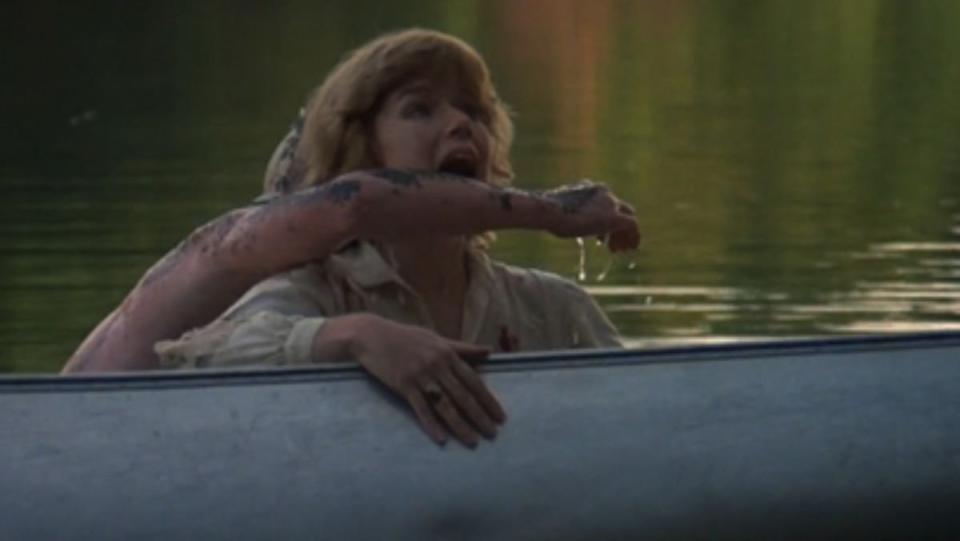
Alison Mattingly: Of all the horror tropes, nothing feels more synonymous with the genre to me than the “final scare.” One of my earliest and fondest horror memories is watching the original Friday the 13th with my parents one Halloween when I was in my early teens (after begging my mom to let me buy the DVD from a bargain bin at the local Wal-Mart). Having been a lifelong chicken with a morbid curiosity for all things dark and scary, I had decided I was ready to watch my first adult horror film. I proceeded to watch the ’80s slasher with awe and terror, enjoying the rollercoaster ride of its thrills.
However, the moment that sealed the deal for me as a born-again horror fan was the final scare trope, which to this day, I think Friday the 13th perfected. With the killer dead and the danger seemingly over as help arrives the next morning, Jason Voorhees springs from the depths of Crystal Lake to drag Alice into the water and deliver one final burst of fear for an unsuspecting audience. I can still distinctly remember both my mom and I screaming. She burst into tears proclaiming, “I hate this movie”, and I, quietly in my nervous laughter, proclaimed my love.
The Horror Trope: Running Up the Stairs
The Movie: Scream (1996)
“…They’re all the same. Some stupid killer stalking some big-breasted girl who can’t act who’s always running up the stairs when she should be going out the front door…”
Tai Gooden: Iconic final girl (and anti-horror advocate) Sidney Prescott says these exact words in Scream (1996) during her first phone call with Ghostface. As we now know, this very-meta franchise often pokes fun at horror’s many tropes while simultaneously leaning into them. And when it comes to horror tropes, “running up the stairs” is one of the most nonsensical and hilarious ones in existence. Rarely if ever does it make sense to go upstairs to evade a killer, yet countless people (specifically women) have met their demise by making this choice.
Like the audience, Sidney may believe she’s smarter than the average horror character. But that’s simply not the case when she’s the one in peril. Moments later, Ghostface appears and, after a brief scuffle, Sidney tries to go out the front door but the lock chain holds her back. Does she run out of the back door instead? No. She heads straight up the stairs for a heavy dose of irony. Thankfully, final girl plot armor worked to her advantage, saving her from Ghostface’s knife.
The Horror Trope: The Mirror Gag
The Film: An American Werewolf in London (1981)
Kyle Anderson: As soon as you see a bathroom in a horror movie, you can all but guarantee bad stuff will happen. One of two things can happen. One, someone will die in the shower, which is a trope of its own. The other is having the life scared out of you with a hideous monster or other nasty sight in the bathroom mirror behind our hapless victim. You can see this trope coming a mile away. If the camera lingers too long on the sink, it’s over. The person looks at themselves in the mirror, then they go to splash some cold water on their face, and then when they look up, someone’s behind them!
Either it’s a figment of their imagination, or a portent of something bad, or just a real monster or killer. But you WILL be scared, mark my words. The variant of this one, if not the splashy-water set-up, is if the person opens the medicine cabinet. Oh dear heavens, when they shut that thing and look in the mirror again, terror ensues.
While many movies have used a scary thing in the mirror, the best and arguably first real instance of the trope version comes in 1981’s An American Werewolf in London. The movie had already had a few fake-out jumpscares to this point, but about halfway through the movie, our hero David goes to the bathroom, rifles through his new girlfriend’s medicine cabinet, and then is terrified by the grinning visage of his dead and decaying friend Jack behind him. It’s part funny, part scary, an all-time great.
The Horror Movie Trope: The Police Don’t Believe You
The Film: Barbarian (2022)
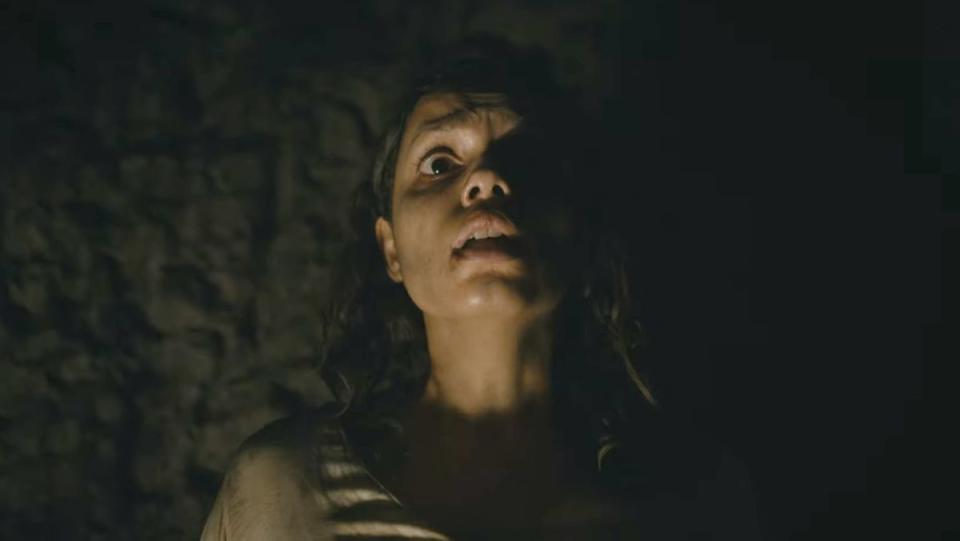
Lindsey Romain: Something in horror that always works on me, even though I hate it, is the “police don’t believe you” trope. It’s a step above “no cell service” in terms of frustration. We’re trained to think the police are the ultimate saviors in moments of danger, but as with real life, that’s rarely the case in horror. They often cause even more death and damage. An ineffective cop is one thing, but cops who blatantly disbelieve our protagonist are even worse. We see it in movies like Cabin Fever and Fright Night, and most recently in Barbarian.
When heroine Tess finally escapes her basement prison and finds law enforcement, she’s met with disbelief. They see her ragged conditions and assume she’s a vagrant, abandoning her to danger. It’s even thornier considering Tess is a Black woman and police violence against Black people remains a horrifying reality in the United States. Horror is best when it’s reflecting real-world truths, even when it’s uncomfortable. Tropes like this may not be pleasant, but they’re certainly effective—and even educational. Tess is the hero of Barbarian in spite of the police who failed her, cementing her as one of the best final girls in recent memory.
The Horror Movie Trope: Creepy Kids
The Film: The Exorcist (1973)
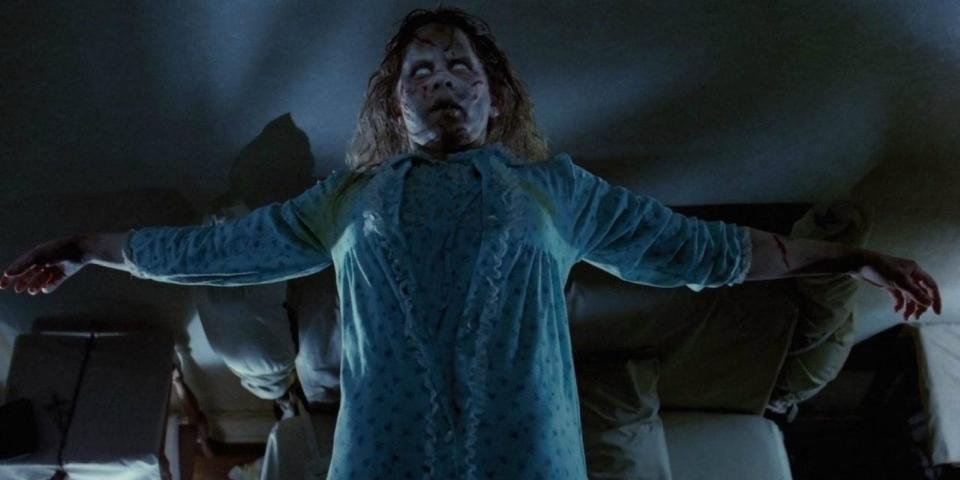
Eric Diaz: I believe the children are the future as much as the next person. But even those of you with children of your own know that kids are sometimes just really creepy. You ever walk into a room with a preschooler having a full conversation with someone not there? Or perhaps they are singing an eerie tune to themselves. Then you know what I’m talking about. However, kids are by far the creepiest in horror films. From The Shining’s ghostly twins, to little Damien in The Omen, and even the chorus of ghostly youth at the start of Stephen King’s It, creepy kids are enough to make you lose some sleep.
But the princess of creepy kids remains poor possessed Regan McNeil in The Exorcist. Her transformation from innocent 12-year-old to filth-spewing demon retains all of its power 50 years later. There’s just something truly terrifying about what’s supposed to be innocent corrupted by evil. It will always be one of horror’s most effective tropes because of this.
The Horror Movie Trope: “Lets Split Up!”
The Film: Cabin in the Woods (2011)
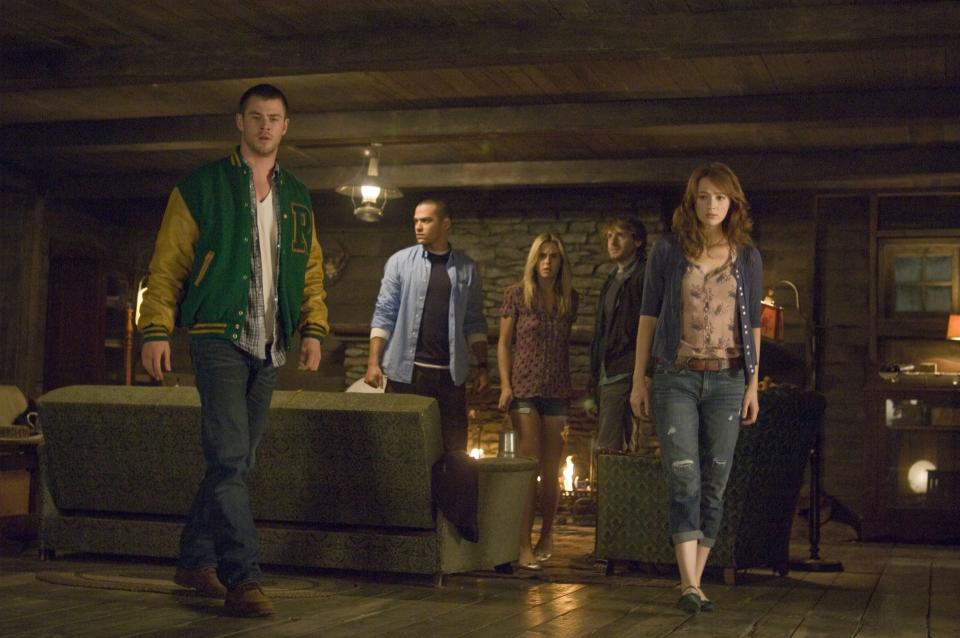
DarkSkyLady: Every time this horror trope pops up through darkened homes, abandoned silos, or dank forests, audiences curse or praise the horror gods. When facing an unknown threat, they need to recall Colonel Mustard’s “there’s safety in numbers.” From films like You’re Next to The Strangers 2: Prey at Night to earlier classics like the Halloween franchise and Friday the 13th, whether stated or implied, splitting up is often the death knell for characters. Yet, we love it because it’s fun! It gives viewers a feeling of superiority that, in the same position, they’d survive.
Then there are films like Cabin in the Woods, which seek to explain this ridiculous “let’s split up” decision. It’s a gas that leads to poor decision-making! In this movie, one character, Marty, hilariously reflects the audience’s thoughts on this bright idea when he incredulously says, “Really?” Whether a film shows foolish characters hacked beyond recognition or reflects viewer savvy, this one whets the appetite for impending carnage.
The Horror Movie Trope: Evil Nuns
The Film: The Devil’s Doorway (2018)
Jules Greene: Evil nuns have never been more in vogue. However, there’s something uniquely compelling to me about evil nuns who aren’t monsters like Valak from The Conjuring movies, but rather ordinary people. The found footage film The Devil’s Doorway featured a Magdalene asylum in Ireland, run by a chilling Mother Superior played by Helena Bereen. The Magdalene asylums were places where “fallen women” in Ireland (young girls and unmarried women who were pregnant, disabled, or defiant of social norms) were imprisoned and forced to work in inhumane conditions.
Director Aislinn Clarke showcases the brutality of the asylums, with the film’s Mother Superior as the driving force behind all of it. While we don’t have to look far to find evil nun movies today, the painful truth behind The Devil’s Doorway is what turns this trope into a damning exposé of the Catholic Church in Ireland.
The Horror Movie Trope: Humans Are the Real Evil
The Movie: Jennifer’s Body (2019)
Joshua Mackey: My favorite horror trope would have to be “humans are the real evil.” It essentially reveals that, even though there’s something that “goes bump in the night” within the film, people are the true horror. My favorite film with this trope is Jennifer’s Body. Megan Fox’s Jennifer Check is supposed to be the “big bad” in the film. And in some ways, she is. Is she dismissive and mistreats her “best friend” Anita “Needy” Lesnicki (Amanda Seyfried)? Yes. Does she feed on the flesh of the men she preys on as a succubus? Also yes.
However, she was turned into the film’s monster by Nikolai Wolf (Adam Brody) and his bandmates who were the real monsters after *spoiler alert* sacrificing her to Satan for their own capital gain. Needy knew not to trust Nikolai and his crew. In the end, she made sure to take care of them.
The Horror Movie Trope: “I’ll Be Right Back…”
The Movie: Halloween (1978)
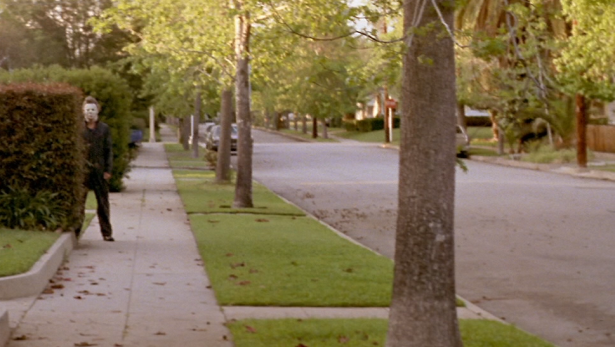
Tai Gooden: If you’re in a terrifying situation and you tell someone that you’ll be right back, then you can bet your a** that you probably will not return. The “I’ll be right back… ” trope almost always proceeds the next round of gore as some bizarrely confident person walks straight towards their last living moments. There are many, many examples of this trope and one of my all-time faves is Halloween. Lynda and her boyfriend Bob break a (formally) cardinal rule about having sex when a killer is on the loose. Bob takes a causal drag of his cigarette before declaring that he will be right back. Of course, Michael kills him and inexplicably nails his body to the wall with a single butcher knife. So much for physics, I guess.
I love this example because it gives us a small and rare window into Michael’s humorous side. He acts like Bob in a ghost costume before eventually taking Lynda out. It’s not the first example of this trope but it is a popular one among horror aficionados.

